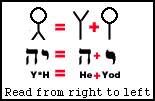Any translation program is only as good as the data which is entered. The sequence of letters is not covered by any known convention, and therefore some interpretation of the pattern is needed. We have seen certain patterns used to indicate the end of a word or phrase and these are described below.
Most Colorado petroglyphs are read from right-to-left. With a stacked (vertical) ligature, letters are read from bottom-to-top and are usually associated with prayers or other references to God. Quite a few of the Colorado petroglyphs are religious in nature. The reverse is true for earthly matters, which are read from top-to-bottom. These usually are informative petroglyphs which tell of water and shelter. With experience, even complex ligatures can be successfully broken down into their correct sequence and will result in accurate translations.
Distinguishing between word groups, without the benefit of word spacing, was accomplished by repeating the last letter in a word or phrase twice. A double letter, therefore, is a helpful indicator in determining how the alphabetical letters should be read. This rule is not adhered to completely and some scripts simply end with no duplicity. We have noticed some words and phrases that make the last letter in a series much larger than the preceding ones, while others rotate the letter upside-down to indicate the end.

The photograph above is of the most famous "old Negev" or First Tongue script found in North America. Heavily chalked and scrutinized by the likes of Barry Fell and other epigraphers, no logical translation has ever been made and published of this script until now.
We are using McGlone's own drawings of this panel and have duplicated this below to allow the script to be seen more clearly. McGlone made his drawings before subsequent investigators chalked and painted the petroglyphs, often including natural cracks and spalls in the recorded glyphs.
 You will note that we have broken the script into word groups, starting from the right and working towards the left. Translations can be verified by using the on-line translation program. We will explain each section in detail.
So far, this group of signs appears to be a sort of advertisement for staying, in effect, ...at the temple of "El" protection, shade and accommodations are provided to the general public... All of these translations were made by converting the "old Negev" symbols into their corresponding proto-Hebrew sounds and then using a Thalmudic-Hebrew to English lexicon which is encoded in the translation program. Although the program is not entirely complete, most of the common words will be found if it is used correctly. Viewzone would like to hear from any attempts at translating in the field. We hope to share more detailed transcripts in the near future.
|
 Ligatures are the result of old script being combined in such a way that the alphabetical letters, when viewed as a whole, form a picture or drawing that helps understand the word or phrase. This method was used so that people who did not understand the sound values of the various symbols could recognize and understand the meaning of the writing. An example of this would be the combination of two letters "yod" and "hey" which could be combined to form a "stick man" with a head and legs but no arms. Such a ligature was commonly used to represent the name of God, Yah.
Ligatures are the result of old script being combined in such a way that the alphabetical letters, when viewed as a whole, form a picture or drawing that helps understand the word or phrase. This method was used so that people who did not understand the sound values of the various symbols could recognize and understand the meaning of the writing. An example of this would be the combination of two letters "yod" and "hey" which could be combined to form a "stick man" with a head and legs but no arms. Such a ligature was commonly used to represent the name of God, Yah.